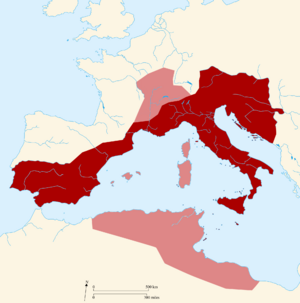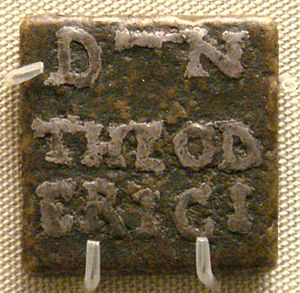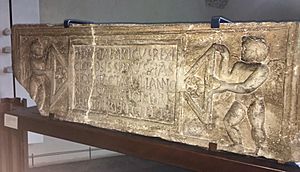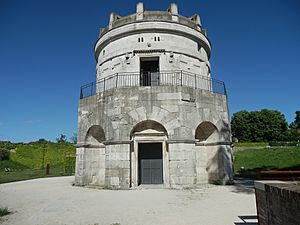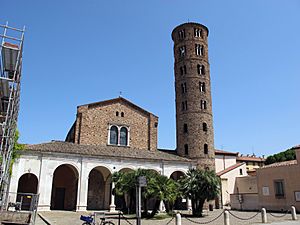Theodoric the Great facts for kids
Quick facts for kids Theodoric |
|
|---|---|
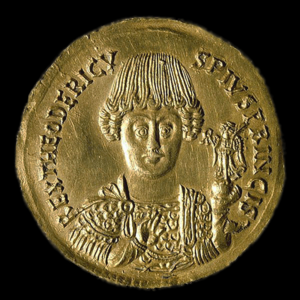
A special coin (or medallion) showing Theodoric. Notice his Germanic mustache and hair.
|
|
| King of the Ostrogoths | |
| Reign | 475 – 30 August 526 |
| Predecessor | Theodemir |
| Successor | Athalaric |
| King of Italy | |
| Reign | 15 March 493 – 30 August 526 |
| Predecessor | Odoacer |
| Successor | Athalaric |
| King of the Visigoths | |
| Reign | 511 – 30 August 526 |
| Predecessor | Gesalec |
| Successor | Amalaric |
| Born | 454 near Carnuntum (now in Lower Austria), Western Roman Empire |
| Died | 30 August 526 (aged 71–72) Ravenna, Ostrogothic Kingdom |
| Spouse | Audofleda |
| Issue | Amalasuintha Theodegotha Ostrogotho |
| Dynasty | Amali |
| Father | Theodemir |
| Mother | Ereleuva |
| Religion | Arianism |
Theodoric the Great (born 454, died 526) was a powerful king. He was also known as Theodoric the Amal. He ruled the Ostrogoths from 471 to 526. He became the independent ruler of Italy in 493. Theodoric was also a guardian for the Visigoths from 511 to 526. He was an important official in the Eastern Roman Empire.
Theodoric's empire was huge. It stretched from the Atlantic Ocean to the Adriatic Sea. Even though he only used the title 'king', some people thought of him as a Western Roman Emperor. This was because he ruled over many parts of the old Western Roman Empire. He even received symbols of imperial power from Constantinople in 497.
When Theodoric was a young boy, he was sent to Constantinople. He lived there as a hostage. This is where he grew up and received a good Roman education. Around 470, Theodoric returned home. In the 470s, he fought against different groups. He also tried to gain power among the Goths in the Roman Balkans.
The emperor Zeno made him a military commander in 483. In 484, he became a Roman consul. Despite these honors, Theodoric often fought with the emperor. He frequently raided Roman lands. In 489, Emperor Zeno asked Theodoric to attack Odoacer. Odoacer was the king of Italy at the time. Theodoric won in 493.
As the new ruler of Italy, Theodoric kept Roman laws and culture. He also started many building projects across Italy. In 505, he expanded his rule into the Balkans. By 511, he controlled the Visigothic Kingdom in Spain. He also had power over the Burgundian and Vandal kingdoms. Theodoric died in 526. He was buried in a grand tomb in Ravenna. He is remembered in old German stories as the hero Dietrich von Bern.
Contents
Early Life and Adventures
Theodoric was born in 454 in a place called Pannonia. This was near a lake called Neusiedler See. His father was King Theodemir. He was a nobleman from the Amali family. His mother was Ereleuva. Theodoric was born just one year after the Ostrogoths broke free from the Huns. The Huns had ruled them for almost 100 years. Theodoric's Gothic name, *Þiudareiks, means "people-king" or "ruler of the people".
In 461, when Theodoric was about seven or eight, he was sent to Constantinople. He was a hostage there. This was to make sure the Ostrogoths followed a peace agreement. His father had made this agreement with Emperor Leo I. The agreement meant Constantinople would pay the Goths a lot of gold each year. Theodoric received an excellent education from the best teachers in Constantinople. He learned to read, write, and do math.
Theodoric was treated well by Emperor Leo I. He stayed in Constantinople until 469. During this time, he learned a lot about Roman culture. This helped him understand the Roman way of life.
When Theodoric returned home in 469 or 470, he took charge of the Gothic areas. These areas were once ruled by his uncle, Valamir. His father became king. Soon after, Theodoric fought against the Sarmatians. He crossed the Danube River with 6,000 warriors. He defeated the Sarmatians and killed their king, Babai. This event likely showed everyone that he was a strong leader. He kept the conquered area of Singidunum for himself.
Throughout the 470s, Theodoric led many campaigns. He fought against other Gothic groups and enemies of the Eastern Roman Empire. This made him a very important military and political leader. One of his main rivals was Theodoric Strabo. Strabo means "the Squinter." He was a chieftain who had led a big revolt against Emperor Zeno. Theodoric worked with the emperor. In return, Zeno made him a commander of the Eastern Roman forces. His people became allies of the Roman army.
Emperor Zeno tried to turn one Germanic leader against another. In 476 or 477, Theodoric asked for new lands. His people were facing a famine. Zeno then offered Theodoric Strabo the command that belonged to Theodoric. Theodoric was very angry about this. He attacked communities in the Rhodope Mountains. His forces took livestock and killed farmers. They also looted and burned the city of Stobi.
Eventually, Zeno offered a settlement. But Theodoric refused it at first. Theodoric sent a trusted friend, Sidimund, to negotiate with Zeno. While they were talking, Zeno sent troops to attack some of Theodoric's wagons. These wagons were protected by his general, Theodimund. Theodoric's Goths lost about 2,000 wagons. About 5,000 of his people were taken captive.
In 479, he settled his people in Epirus. His relative Sidimund helped him. In 482, he raided Greece and looted the city of Larissa. Emperor Zeno was in a difficult situation. He made another agreement with Theodoric. In 483, Zeno made Theodoric a top military commander. In 484, he was named a consul. This meant he commanded important Roman provinces.
Ruling as King
Theodoric wanted more power. He often attacked the provinces of the Eastern Roman Empire. He even threatened Constantinople itself. By 486, Theodoric and Zeno were openly hostile. The emperor asked the Bulgarians for help. But Theodoric defeated them too. In 487, Theodoric began a strong campaign against Constantinople. He blocked the city and cut off its water supply. It seems he didn't want to take the city. Instead, he wanted to show his power to the Eastern Empire.
The Ostrogoths needed a place to live. Zeno also had big problems with Odoacer. Odoacer was a Germanic leader and King of Italy. He was supposed to be Zeno's representative. But he was threatening Byzantine land. He also wasn't respecting the rights of Roman citizens in Italy. So, in 488, Zeno ordered Theodoric to overthrow Odoacer. Theodoric moved his people towards Italy in the fall of 488. On the way, he defeated the Gepids in a battle in 489. When he arrived in Italy, Theodoric won battles at Isonzo and Verona in 489.
In 490, Zeno again urged Theodoric to attack Odoacer. Theodoric's army was defeated by Odoacer's forces at Faenza in 490. But Theodoric won the next big battle. This was the Battle of the Adda River in August 490. For several years, the armies of Odoacer and Theodoric fought for control of Italy. In 493, Theodoric captured Ravenna.
On February 2, 493, Theodoric and Odoacer signed a treaty. It said both would rule Italy. Then, on March 5, 493, Theodoric entered Ravenna. A banquet was held on March 15 to celebrate the treaty. At this feast, Theodoric killed Odoacer. He also had Odoacer's most loyal followers killed. This made Theodoric the sole ruler of Italy.
With Odoacer dead, Theodoric needed to settle his people. He decided to settle the Ostrogoths in three main areas. These were around Pavia, Ravenna, and Picenum. Theodoric's kingdom was one of the most "Roman" of the barbarian states. He ruled most of Italy successfully for 33 years.
Theodoric increased his power over other kingdoms. He used marriage alliances to connect with the Burgundian and Vandal kingdoms. He married the sister of the powerful Frankish king, Clovis. He also sent his sister Amalafrida to marry the king of the Vandals. She went with a large dowry and 5,000 troops.
In 504–505, Theodoric expanded his lands in the Balkans. He defeated the Gepids and gained the province of Pannonia. In 507, the Franks defeated the Visigothic king, Alaric II. Theodoric then became the guardian for the young Visigothic king, his grandson Amalaric. The Franks took control of Aquitaine from the Visigoths. But Theodoric was able to stop their other attacks.
In 511, the Visigothic Kingdom came directly under Theodoric's control. This created a huge Gothic empire. It stretched from the Atlantic Ocean to the Danube River. Theodoric made peace with the Frankish Kingdom after Clovis died.
Theodoric was officially a representative for the emperor in Constantinople. But he acted like an emperor himself. He wore purple robes, like the Roman emperors. This showed his "new-imperial status." He believed that "An able Goth wants to be like a Roman." He also said, "only a poor Roman would want to be like a Goth."
Theodoric was a strong military leader. He was able to rule without much supervision from the emperor. Unlike Odoacer, Theodoric respected his agreements. He allowed Roman citizens in his kingdom to live under Roman law. The Goths, however, lived under their own laws. In 519, a mob burned down the synagogues of Ravenna. Theodoric ordered the town to rebuild them at its own cost.
Theodoric faced problems before he died. His daughter Amalasuintha married the Visigoth Eutharic. But Eutharic died in 522 or 523. This meant there was no lasting family link between the Ostrogoths and Visigoths. This also showed the growing problems between the Eastern Empire and the West.
The new emperor, Justin I, was influenced by his nephew Justinian. The Roman Empire's views against the West became stronger. People started talking about Rome's fall. This led to questions about whether barbarian rulers were truly legitimate. Theodoric's good relationship with the Roman Senate also worsened. This was because of a suspected plot in 522. In 523, Theodoric arrested the philosopher Boethius and his father-in-law Symmachus. They were accused of treason. Theodoric had Boethius executed in 524.
Theodoric had a complex relationship with his son-in-law, Sigismund of Burgundy. Sigismund was a Catholic Burgundian king. They had peace for 15 years. But in 522, Sigismund killed his own son, Sigeric. Sigeric was Theodoric's grandson. This made Theodoric furious. He invaded the Burgundian kingdom with the Franks. Sigismund's forces were defeated. Sigismund's brother, Godomar, became king of the remaining Burgundian land.
Theodoric's sister, Amalafrida, tried to change who would be the next Vandal king. This was after her husband, the Vandal king Thrasamund, died. The new Vandal king, Hilderic, was Catholic. He had Amalafrida and her Gothic guards killed. Theodoric was very angry. He planned to attack the Vandal kingdom. But he died of an illness in the summer of 526.
Theodoric was succeeded by his grandson Athalaric. Athalaric was only ten years old. So, Theodoric's daughter Amalasuintha ruled as regent. Her job was to follow her father's plans. She tried to work with the Roman Senate and keep peace with the emperor. After Theodoric's death, the Goths were no longer united. His grandson Amalaric ruled the newly independent Visigothic kingdom.
Family Life
Theodoric was married once.
He had two daughters with a woman from Moesia. Her name is not known:
- Theodegotha (born around 473). In 494, she married Alaric II. This was part of her father's alliance with the Visigoths.
- Ostrogotho (born around 475). In 494 or 496, she married King Sigismund of Burgundy. This was part of her father's alliance with the Burgundians.
By his marriage to Audofleda in 493, he had one daughter:
- Amalasuintha, who became Queen of the Goths. She married Eutharic. They had two children: Athalaric and Matasuntha. Matasuntha married two times but had no children. Any hope for a united Gotho-Roman Empire from this family was lost.
After Theodoric died in Ravenna in 526, his grandson Athalaric became king. Athalaric's mother, Amalasuintha, ruled for him from 526 to 534. However, the Ostrogothic kingdom grew weaker. It was eventually conquered in 553.
Building Projects
Theodoric worked to rebuild Roman cities. He also helped preserve old monuments in Italy. His building projects were so famous that people in far-off Syria heard about them. Theodoric's building program included more new construction and repairs than any Western Roman emperor since Honorius (395–423).
Ravenna's New Look
Theodoric focused most of his building efforts on his capital city, Ravenna. He fixed Ravenna's water supply. He repaired an old aqueduct that was built by Trajan. Many cities were improved by Theodoric's building work. Some of these projects were even better than ancient wonders.
He built a "Great Basilica of Hercules" next to a huge statue of Hercules. To support his Arian Christian faith, he built a small Arian cathedral. It was called the Hagia Anastasis. It has the Arian Baptistery. Three other churches built by Theodoric in Ravenna were destroyed later. Theodoric built the Palace of Theodoric for himself in Ravenna. It was designed like the Great Palace in Constantinople. It was an expansion of an older Roman building. The palace church, Christ the Redeemer, still exists today. It is known as the Basilica of Sant'Apollinare Nuovo. This was Theodoric's personal church. An equestrian statue of Theodoric was placed in front of the palace. Such statues were symbols of power in the ancient world. Theodoric's statue showed he was the undisputed ruler of the western empire.
Theodoric the Great was buried in Ravenna. But his bones were later scattered. His tomb was turned into a church after the city was conquered in 540. His mausoleum is one of the most beautiful buildings in Ravenna. Unlike other buildings in Ravenna, it was made entirely of high-quality stone. The architect decorated the building with patterns. These patterns are found in old Scandinavian metal decorations. This might have been a nod to the Goths' origins in Scandinavia.
Rome's Repairs
The Palace of Domitian on the Palatine Hill was rebuilt. This was paid for by a special tax. The city walls of Rome were also rebuilt. The Senate of Rome celebrated this with a golden statue of Theodoric. The Senate's Curia, the Theatre of Pompey, the city's aqueducts, sewers, and a granary were all fixed. Statues were also put up in the Flavian Amphitheatre.
Theodoric's Religion
In 522, the philosopher Boethius became his chief official. Boethius was a Roman nobleman and a Christian scholar. He was also a philosopher, poet, and mathematician. He translated and commented on Greek thinkers like Aristotle. Boethius's writings became textbooks for students in the Middle Ages. The execution of Boethius made tensions worse between Arians and Catholics. It also raised questions about the legitimacy of barbarian rule.
Theodoric followed the Arian faith. This was a type of Christianity different from the main Catholic Church. In his final years, he became less tolerant of other religions. His death stopped what might have become a major persecution of Catholic churches. This was in response to actions taken by Emperor Justinian against Arians in Constantinople.
Most clergy in the Eastern Empire saw Theodoric as a heretic. This was despite his beliefs being tolerated by two emperors. Towards the end of his rule, arguments arose with his Roman subjects and Emperor Justin I. These arguments were about Arianism. These quarrels led to the deaths of Boethius and Pope John I. They died in 524 and 526, respectively. Relations between Theodoric's kingdom and the Byzantine Empire worsened. But Theodoric's military strength kept the Byzantines from going to war with him. After his death, this changed quickly.
Theodoric's Legacy
Theodoric wanted to bring back the glory of ancient Rome. He ruled Italy during a very peaceful and successful time. People praised him as a new Trajan and Valentinian I. This was because of his building efforts and his religious tolerance. He aimed to combine the best parts of Roman culture with Gothic strength. This was his vision for the future. The good relations between Goths and Romans during his reign are also notable. Memories of his rule made him a hero in medieval German legends. He is known as Dietrich von Bern in these stories.
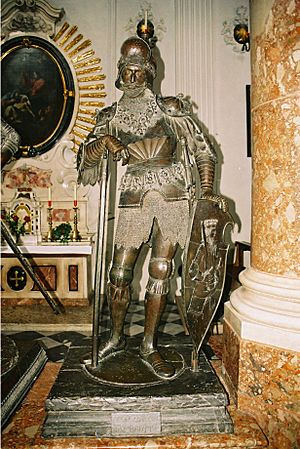
See also
 In Spanish: Teodorico el Grande para niños
In Spanish: Teodorico el Grande para niños
- Alboin
- Alfred the Great
- Ardaric
- Charlemagne
- Clovis I
- Ermanaric
- Gaiseric
- Hermeric
- Liutprand, King of the Lombards
- Liuvigild
- Theodoric I (Visigothic king)
- Anicius Manlius Severinus Boethius
- Odoacer
- Ostrogothic Kingdom
- Totila



